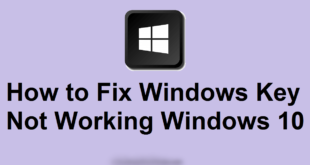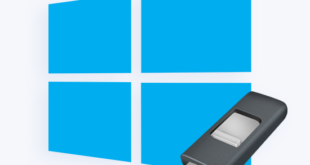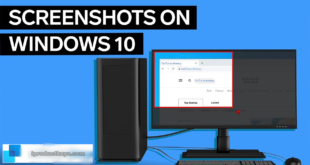Word formatting might be strange at times. How to Delete a Page in Word Mac, and handle hidden page breaks are detailed here.
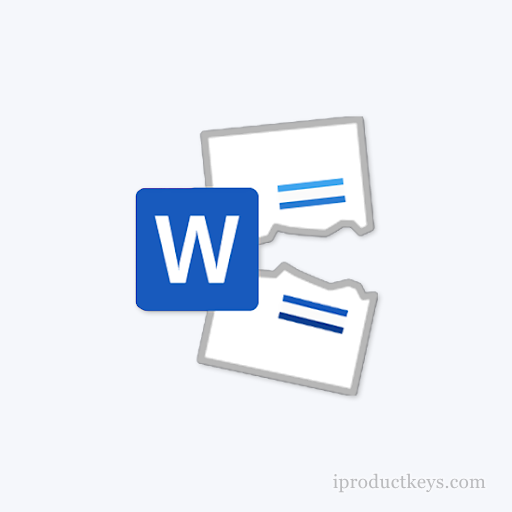
When it comes to word processing, Windows and Mac users both prefer Microsoft Word. You may use its sophisticated tools to help you become a more proficient writer. “However, an unprofessional appearance is made by blank pages in a Word document to editors and prospective employers. However, Microsoft Word might leave blank pages in a document on occasion. Learn how to Delete a Page in Word Mac whenever feasible, you should get rid of these white spaces in Word before sending the document to anybody else.”
No matter your familiarity with Office, you’ll be able to follow the simple, step-by-step directions in this article and learn how to erase a page in Word. Word for Microsoft 365, Word for Windows, Word for Mac, and Word 2021 are all supported in this article.
Here’s how to get rid of the blank pages at the end of your report in Microsoft Word, as well as how to erase a page containing text, images, or other information.
Summary: Delete a page in Word
Table of Contents
- Summary: Delete a page in Word
- Why you Can’t Delete a Page in Microsoft Word?
- How To Delete a Page in Word with Content (for Windows and Mac)
- How to delete a blank page in Word
- Final Thoughts
- To delete a page in MS Word that contains text, graphics, or empty paragraphs, you can select the content to delete and press Delete.
- You can also do this:
- Click/tap anywhere on the page you want to delete > press Ctrl+G.
- In the Enter page number box, type \page.
- On your Keyboard, Press Enter > then select Close.
- Verify that a page of content is selected > then press Delete on your keyboard.
- Voila! You’ve deleted a page!
- If you’re using macOS or Word for Mac, here’s how to delete a page in Word Mac:
- Click/tap anywhere on the page you wish to delete > then press Option+⌘+G.
- In the Enter page number box, type \page.
- Next, press Enter on the keyboard > then select Close.
- Verify that a page of content is selected > then press the Delete button on the keyboard.
Why you Can’t Delete a Page in Microsoft Word?
Users of Word sometimes have trouble deleting pages, even ones that seem to be empty. At first glance, this may be misinterpreted as a bug in the program. Depending on what’s causing it, however, there are straightforward answers.
It’s possible that you added a page break when formatting, but you won’t be able to see it until you make special symbols visible. In Microsoft Word, this produces what seems like a blank page or white space. The same thing occurs when the text color is the same as the background color of the page. Even if there is information on the page, it will seem empty.
Text written in a prepared typeface was also difficult to read for some people. When using the default zoom level, it’s almost impossible to see text smaller than 1 point. Follow our steps below to fix the problem if you are unable to delete a page containing content.
How To Delete a Page in Word with Content (for Windows and Mac)
Do not overwork your mouse by attempting to remove a page that remains blank despite your best efforts. If you want to get rid of unnecessary pages, blank pages, or whitespace in a Word document, then follow these procedures.
Method 1. Hold the Backspace or Delete Key
An easy way to delete an entire page in Word is by holding the backspace or delete key to erase every character on the page. This can be tedious for documents with lots of content, but it works.

This approach could also work for empty pages since you might have blank spaces or other filler characters that you can’t see but that you can erase. Simply drag the flashing cursor to the end of the Word document, then hit and hold either the backspace key or the delete key until the page has been deleted completely.
Method 2. Select the Page Content and Delete It
Utilizing the Go To option in Word is an efficient approach to get rid of a page quickly. Because this is available on all platforms, you can easily recall it and apply it in the future in any setting. Because of this, it is an accessible solution. Using the Go-To tool in Word, you may delete a page by following the procedures that are provided below.
- Open the Find and Replace window using the Ctrl + G keyboard shortcut on Windows or ⌘ + option + G on Mac.
- Switch to the Go To tab. In the Enter page number input box, type in “/page” without quotation marks.
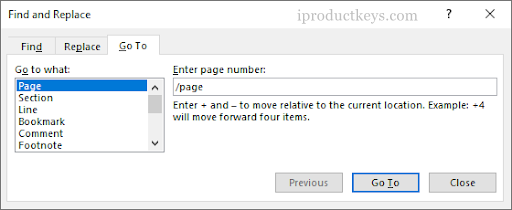
- Hit the Enter key on your keyboard, then click Close. This will select all the content on your page. Press the backspace key or the delete key once to erase everything.
You may rapidly go to certain pages by using the Navigation window, which also provides a preview of the content. On the other hand, you can also use it to eliminate blank pages in Word, which is another useful function. It should not be difficult for you to identify a page that is blank and follow the instructions below to remove it from your manuscript.
- Go to the View tab in the ribbon displayed on top of your window, and then place a check next to the Navigation Pane option. If you’re using Windows, use the Ctrl + H keyboard shortcut to quickly toggle the pane.

- Switch to the Pages tab in the left panel, and click on the blank page thumbnail preview to instantly jump to the beginning of the page. If you’re deleting a page with content, locate it.

- Scroll to the bottom of the page and click once while holding the Shift key on your keyboard. This will select everything on the page.
- Press the backspace key or the delete key once to remove all contents and delete the page. This should help you remove the page from your document.
Method 4. How to delete a page in Word – Delete Extra Paragraph Mark
In certain instances, you won’t be able to delete a blank page because it contains characters that aren’t displayed by default. To indicate the start of a new paragraph, you should use the pilcrow sign, which is represented by the tilde () character. They will not be displayed unless you update certain of your settings, since they are hidden by default.
Here are the steps to make the paragraph symbol visible in a Word document, then delete it to remove a seemingly blank page or whitespace in your document.
- In most versions of Word, you can toggle the visibility of the paragraph mark from the Home tab in the Ribbon. Simply click on the button which displays the ¶ symbol until you start seeing the marks in your document.

- Erase extra paragraphs where you see the ¶ symbol using the backspace key or the delete key on your keyboard. After removing the last paragraph marker, the page should be deleted.
- If the Show/Hide toggle didn’t work, try these alternative steps to make the paragraph mark visible in Word.
Word for Windows
To delete a blank page in Windows, by making the paragraph mark visible;
- Go to the File tab and select Options. This is going to open the Word Options dialog box.

- Switch to the Display tab in the left panel.
- Click on the Paragraph marks check box in the Always show these formatting marks on the screen section. You can also turn every mark visible by checking the Show all formatting marks option to reveal more symbols.
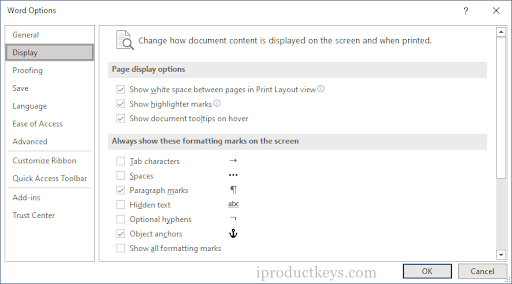
- Change how document content is displayed on the screen and when printed
In Word for Mac
- Click on Word from the menu bar on top of your screen and select Preferences. You can also use the ⌘ +, (comma) keyboard shortcut to open the dialog box.
- Select View from the Authoring and Proofing Tools section.
- Place a checkmark next to Paragraph marks in the Show non-printing Characters section. You can also turn every marker visible by selecting the All option.

Method 5. How To Delete Page Breaks in Word
A manual page break you inserted may be stopping you from being able to delete a page in Word. Page breaks usually serve to create separate pages on demand, which may be left in while you alter and delete parts of a Word document.
Below are the steps to learn how to remove a page in Word when you have one or more page breaks in your document.
- Find the ———— Page Break ———— in your document and place your cursor at the end of it.

- Press the backspace key or the delete key to remove the page break. This should also delete the page it was on if the page was empty.
Method 6. Use an Online Page Removal Tool
No luck deleting the unwanted page in Word? Your last solution could be an online tool. Smallpdf offers a way to convert your Word documents into a PDF file and then lets you make edits to the converted file. This includes a way to delete any unwanted pages, white pages, and empty pages.
Here’s how you can use the Smallpdf Word to PDF tool and the Delete Pages tool to remove a page in Word.
- Navigate to smallpdf.com/word-to-pdf using any web browser on your device.
- Click on the Choose Files button, or simply drag your Word document into the converter and wait for it to turn into a PDF. The process will automatically begin.
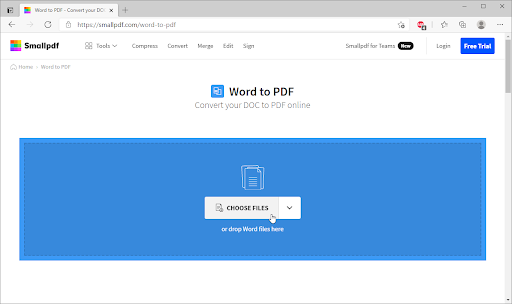
- Once the conversion is complete, click on the Edit PDF button. You’ll be redirected to a new tool, which allows you to remove pages from a Word document.
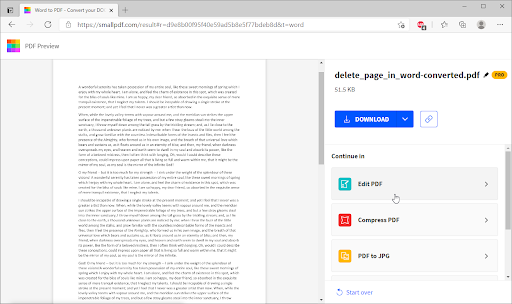
- Click on Tools from the page toolbar, and then select Delete PDF Pages.
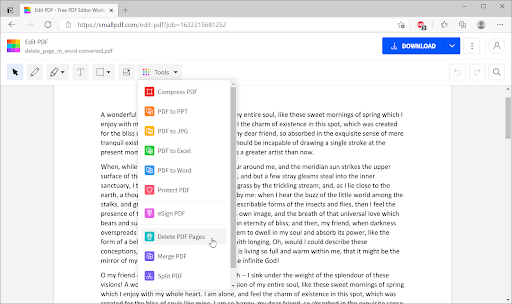
- Hover over the page you want to delete, and then click on the Delete icon displayed by a garbage bin. After deleting every unwanted page, click Apply Changes.

- Click the Download button to save the edited file on your computer. If you want to convert the file back to a Word document, use the PDF to Word converter to change your file back to its original format.
How to delete a blank page in Word
Word includes a non-deletable end-paragraph that sometimes gets pushed out to a new, blank page at the end of a document. Wondering how to delete a page in Word – the blank page?
To delete blank pages in a Word document, you must make the end paragraph fit onto the preceding page. The most sure-fire way is to make the end paragraph very small (1 point).
Now, to delete a blank page in Word (including delete a blank page in Word for Mac: Word for Microsoft 365 for Mac, Word 2021 for Mac, Word 2019 for Mac, Word 2016 for Mac, Word 2013, Word 2010):
- Press Ctrl+Shift+8 (⌘+8 on a Mac) to show paragraph marks.
- Select the paragraph mark.
- Select inside the Font size box, type 01, and then press Enter. If you do this, the paragraph now fits on the preceding page, removing the unwanted blank page.
- Press Ctrl+Shift+8 again to hide the paragraph marks (⌘+8 on a Mac).
If that paragraph unfortunately still doesn’t fit on the preceding page, you can make the bottom margin smaller (Layout tab > Margins > Custom Margins, and set the bottom margin to something small, like 0.3 inches). This should work.
Convert Word to PDF
Another way to delete blank pages is to convert Word to PDF. Here are the steps to help you convert Word to pdf.
- Go to File > Save As
- Pick a place to save the file > then choose PDF for the Save as type.
- Select Options in the Save As dialog box.
- Under Page range, choose Page(s) > then specify your non-blank pages. For instance, if page 5 of your document is the blank page you can’t get rid of, specify pages from 1 to 4.
- Select OK, and then select Save.
Recap: How to Delete a Page in Microsoft Word
- Click or tap anywhere on the page you want to delete, and press Ctrl+G.
- In the Enter page number box, type \page.
- Press Enter on your keyboard, and then select Close.
- Verify that a page of content is selected, and then press Delete on your keyboard.
Final Thoughts
We hope you learned how to delete a page in Word, including “Delete a Page in Word Mac”. It’s not difficult, right? Now that the pesky page is gone, you can continue working on your projects.
Our Help Center offers hundreds of guides to assist you if you require further help. Return to us for more informative articles, or contact our experts for immediate assistance.

